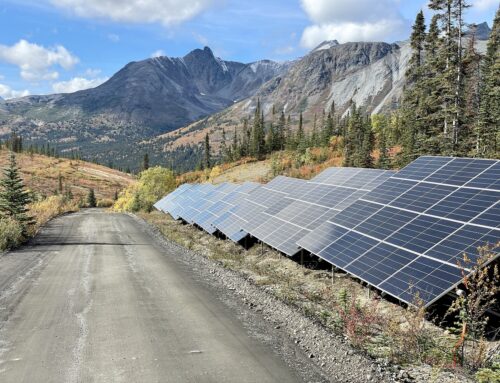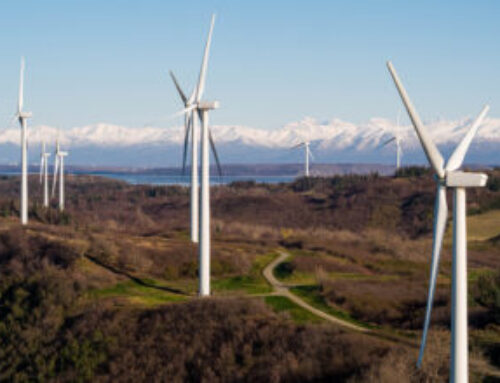Solar industry electrifies pushback in rural areas of Chesapeake Bay region
October 6, 2024
Cover photo: The Elk Hill solar farm near Mercersburg in Franklin County, PA, is a 48-megawatt facility that came online in 2021 and 2022. (Dave Harp)
Solar may be the cheapest and easiest-to-install energy source driving the nation’s push for renewable power. But in rural hamlets across the Mid-Atlantic, efforts to unleash widespread sun-based power are encountering pushback from local officials and residents.
Solar developers often look to the rural U.S. to host their sprawling arrays because that’s where the open land is. And the potential new neighbors of those projects say it puts a disproportionate burden on their communities — such as the loss of prime farmland, disruption of bucolic views and increased stormwater runoff.
To the frustration of solar developers and environmental groups, local leaders are rejecting many solar farms. The opposition is slowing the solar industry’s rollout in Maryland and Virginia and has kept Pennsylvania among the lowest-ranking states in solar adoption.
Renewable energy projects in general are facing more friction nationwide. An analysis by USA Today found that in 2023, for the first time, more solar and wind projects were blocked by local governments than approved.
In Lebanon County, PA, where this farmland is located, an 859-acre solar project was blocked in 2022 by residents, many of whom wanted to preserve the area’s scenic view. (Nicholas/CC BY 2.0)
Robert Bryce, a Texas-based journalist and author of several books critical of the renewable energy transition, frames it as a “David vs. Goliath” story.
“This isn’t about climate change,” he said. “It’s about money. And who’s getting the money? It’s big banks, big businesses, big law firms and big [nongovernmental organizations]. And who are the losers? It’s rural landowners and rural homeowners.”
‘Not in my backyard’
Bryce maintains a running nationwide database of locally enacted wind and solar project rejections and restrictions. The list has grown to more than 700 cases since its 2015 inception.
Since early 2023, according to Bryce’s database, eight medium to large solar farms in Pennsylvania have been shot down by activists and public officials based on local zoning and land use laws — although one of those denials was overturned by a county court and allowed to proceed.
A dozen more were turned down in Virginia during that span. Maryland, which prohibits local governments from outright denying renewable energy proposals, had no such instances.
In virtually all of the denials, staunch opposition from local residents surfaced.
The most frequently cited concerns included declines in property values, damaging of pastoral views, glare, harm to wildlife, noise pollution, stormwater runoff and uncertainty over the fate of the panels after operations cease.
Some of the fears voiced at the often heated and extended public hearings have been far-fetched. One Pennsylvania resident worried that migrating geese would mistake the shine from solar panels for a lake and come crashing down.
And statements like this, from a woman opposing a 40-acre solar farm in Nanticoke, PA, are not unusual: “I am 100% for solar power but not in my backyard.”
Local sentiment sometimes holds that suitable locations for larger solar projects should be restricted to brownfield sites, abandoned coal land, landfills or the roofs of large warehouses. Solar developers say those sites are never off the table, but they would not alone provide the vast acreage needed to meet renewable energy goals.
In some cases, several observers have said, opposition has been fanned by outside groups backed by fossil fuel interests or organizations opposed to renewable energy for political reasons.
But permeating the resistance is the simple fact that people don’t like changes to their communities, suggested John Quigley, a senior fellow at the University of Pennsylvania’s Kleinman Center for Energy Policy.
John Quigley, former secretary of the Pennsylvania Department of Environmental Protection, stands next to a solar array in Lower Allen Township near Harrisburg. Quigley thinks some townships push back against solar projects partly because the developers aren’t engaging enough with the public to allay fears.
“Many aren’t prepared for those things that alter the character of the community in some ways. It’s a jolt,” he said. “At the end of the day, folks are concerned that the community is going to change somehow.”
“I grew up in rural northern Pennsylvania,” added Sharon Pillar, executive director of the nonprofit Pennsylvania Solar Center. “[Solar farms look] different, and I think that is often the case for people living next to a different use of the land they’ve never seen.”
Pennsylvania struggles
Pennsylvania has been well behind Virginia and Maryland in the effort to develop its solar industry.
As of late 2023, according to the U.S. Solar Photovoltaic Database, there were 70 ground-mounted solar projects of at least 1 megawatt capacity in Maryland for a total of 440 MW. In Virginia, there were 69 projects producing 2,926 MW.
Pennsylvania only had 34 solar projects, representing 221 MW of energy.
Some observers say opposition to solar farms there has been more widespread than the resistance to hydraulic fracturing for natural gas, which arrived in Pennsylvania in the late 2000s. The arrival of large-scale solar, though, has touched off the same scramble to update zoning and land use regulations.
Although groups such as the Pennsylvania State Association of Township Supervisors and the Penn State Extension Energy Team have been handing out model ordinances to help municipalities, “it’s still kind of the wild, wild West in Pennsylvania when it comes to solar development,” Quigley said.
“For the most part, communities don’t think that much about it until it’s there,” observed Daniel Brockett, assistant state program leader for the Penn State team.
The supervisors association has nearly a dozen different model zoning ordinances with variations on such things as setback distances, screening, lighting, percentage of a property that can be covered by panels and decommissioning the site.
One town’s plight
Perhaps the greatest tension within Pennsylvania communities dealing with solar build-out is that between financially strapped dairy farmers who wish to lease their land temporarily for a solar farm and their neighbors who would prefer to look out on pasture and crop land.
In Lebanon County’s North Annville Township, a solar developer wanted to build an 858-acre solar farm on land owned by 12 different farmers who said revenue from the leases would help them keep their farms. In 30 years or so, the solar panels would be removed and the land returned to its original state.
But at a standing-room-only zoning hearing, most township residents who spoke opposed the project. One reason was that it would impair their scenic views.
That angered a farmer in the township who was not part of the project. “It’s always hard seeing neighbors against neighbors. And I don’t like seeing farmland disappear. But you ought to be able to do what you want to do with your land within reason,” said Zach Alger in an interview.
In April 2022, the township supervisors denied a conditional-use permit for Lebanon Solar’s project. The case was appealed to county court. There, Judge Bradford Charles upheld the denial on two narrow grounds of incomplete information, while throwing out other reasons that stopped the project.
On the key matter of landowner versus neighbor rights, he was clear, writing, “We cannot and will not depreciate the importance of the landowners’ funda-mental right to pursue such a project on their own land.”
The project’s developer has appealed the decision to Commonwealth Court.
Skyler Zunk, CEO of the Virginia-based pro-solar group Energy Right, meets attendees during a “Solar 101” event held in Fluvanna County, VA, in July 2024. (Melissa Hill)
Part of the blame for high solar denials in Pennsylvania rests with solar developers themselves, analysts said. Too often, developers submit broad, undetailed applications to municipal officials, then sit back and wait for an answer without interacting with the residents, Quigley suggested.
“There seems to be a lack of engagement with local communities to address their concerns and give them a voice, to create a win-win,” he said.
Dave Sanko, executive director of the township supervisors association, agrees. “I think people will find the middle ground for what works in their community. That cooperation and communication is a huge first step.”
Meeting climate goals
Under the Virginia Clean Economy Act (VCEA) of 2020, the state has mandated a transition to 100% renewable energy by 2050. Local opposition to solar farms threatens to derail that goal, said Ronald Meyers, director of the Renewable Energy Facilities Siting Project at Virginia Tech.
The solar industry has faced a learning curve in Virginia, he explained. The earliest developers were mainly from the West and not accustomed to designing projects on steep slopes or in a region that experiences frequent heavy bouts of rain.
The Virginia Department of Environmental Quality issued a $245,000 fine after a newly constructed 200-acre solar panel project in Essex County sent brownish water gushing into Muddy Gut Creek, a tributary to the Rappahannock River. The incident helped spur action by Gov. Glenn Youngkin’s administration to toughen rules for how solar developments must handle their stormwater.
Last year, Meyers’ colleagues at Virginia Tech were awarded a $3.4 million DEQ grant to analyze the stormwater implications of solar farms over six years.
The VCEA directs Dominion Energy to propose 16,100 MW of onshore wind and solar installations by 2035. Those projects would require at least 161,000 acres of open land. A task force last year estimated that the state has nearly 9 million suitable acres — seemingly more than enough to meet that demand.
But Meyers believes the state will end up needing to generate far more energy from renewables than what current projections estimate, largely because of skyrocketing electricity demands from data centers, electric vehicles and ongoing conversions from gas furnaces to HVAC systems. He suspects 2 to 4 million acres will be required.
And that will put an even greater emphasis on how solar developers and local communities get along, he said. Lately, many counties have been unwilling to put out the welcome mat. An analysis by Energy Right, a Virginia-based conservative pro-solar group, found that about one-third of counties have banned or severely restricted solar installations in recent years.
Skyler Zunk, Energy Right’s CEO and co-founder, said much of his work focuses on undoing misperceptions about solar projects in rural areas. “We’re working in a lot of counties that have never been home to any power generating facilities of any kind,” he said. “Each project deserves to be considered on its merits. Bad projects should be denied.”
Clean energy advocates tried to get around the problem in this year’s legislative session in Richmond. One bill sought to bar local governments from outright prohibiting solar developments. The legislation was later watered down to restrict localities only from limiting the total amount, density or size of projects in most instances. A second bill would have allowed projects blocked locally to appeal to the State Corporation Commission. Neither passed.
“I think it mislabels the problem,” Virginia Tech’s Meyers said of the failed bills. “I think developers need to change their ways.”
Who decides?
In Maryland, the final say over whether a renewable energy project goes forward belongs to the state Public Service Commission (PSC). As more solar projects have been proposed, that arrangement has triggered a power struggle between the state regulators and some local governments.
The Maryland Supreme Court at least temporarily settled the legal question by upholding the PSC’s superseding status in 2019 after a challenge led by Washington County. But the political battle rages on.
“Cheerleading on climate change at the expense of Maryland’s communities and agricultural sector is shortsighted and irresponsible, especially when future food production becomes increasingly important on an ever-growing planet,” said Jay Falstad, executive director of the Queen Anne’s Conservation Association, in a February editorial. “Right now, energy siting policies in Maryland are a chaotic mess in desperate need of leadership and a smart, balanced plan.”
Farmer Rich Walbert leased 100 acres in Queen Anne’s County, MD, to accommodate a 15-acre solar farm.
Rich Walbert, 63, began negotiating with Nexamp four years ago after the solar developer approached him about installing panels on 15 acres of his 100-acre leased farm in northern Queen Anne’s County on the Eastern Shore. In mid-September, the two sides finally reached an agreement. Walbert said other landowners should take a similarly measured approach toward leasing their land — to protect their own interests as well those of their neighbors.
“As a landowner, you have the advantage, and if you don’t like what you hear, you can tell [the developer] to go away,” Walbert said. “In my personal belief, solar is agriculture. You’re using a natural resource. The sun has been there from the beginning. Let’s utilize it.”
Solar advocates say more willingness to accept projects at the local level is crucial because time is of the essence. Cleaner energy sources need to come online as soon as possible — for the sake of a warming planet and to have enough power on hand with increasing demands from data centers, cryptocurrency and extreme weather.
“State and national governments might be setting climate and energy targets, but most project-specific decisions are made at the local level,” concluded a survey of attitudes of Pennsylvania policymakers that was published in August in the journal Nature Energy.
“Solar is the cheapest form of energy, period,” said Sharon Pillar of the Pennsylvania Solar Center. “It scares me to think what we need to do and how quickly we need to do it.”
Search
RECENT PRESS RELEASES
Related Post



